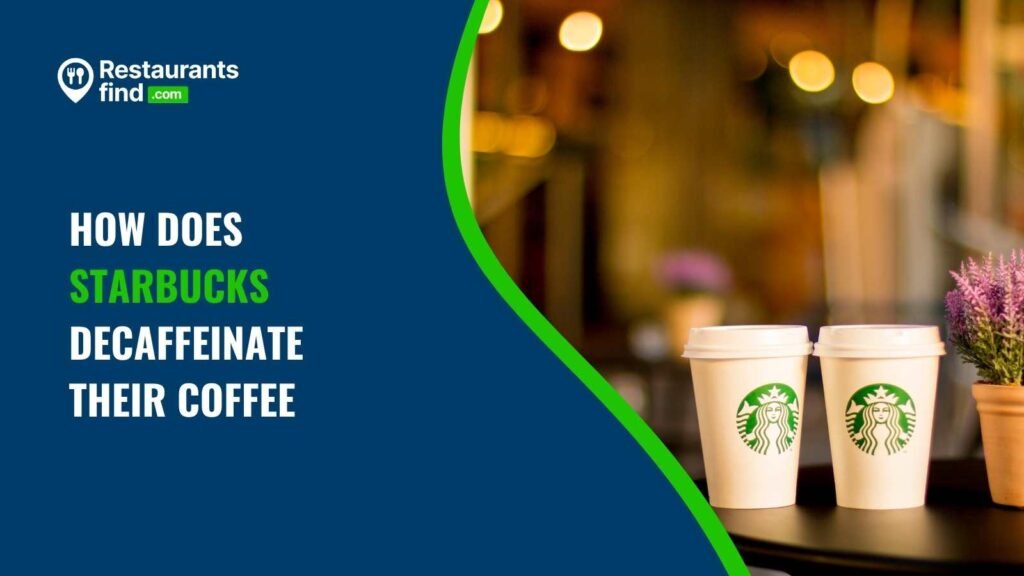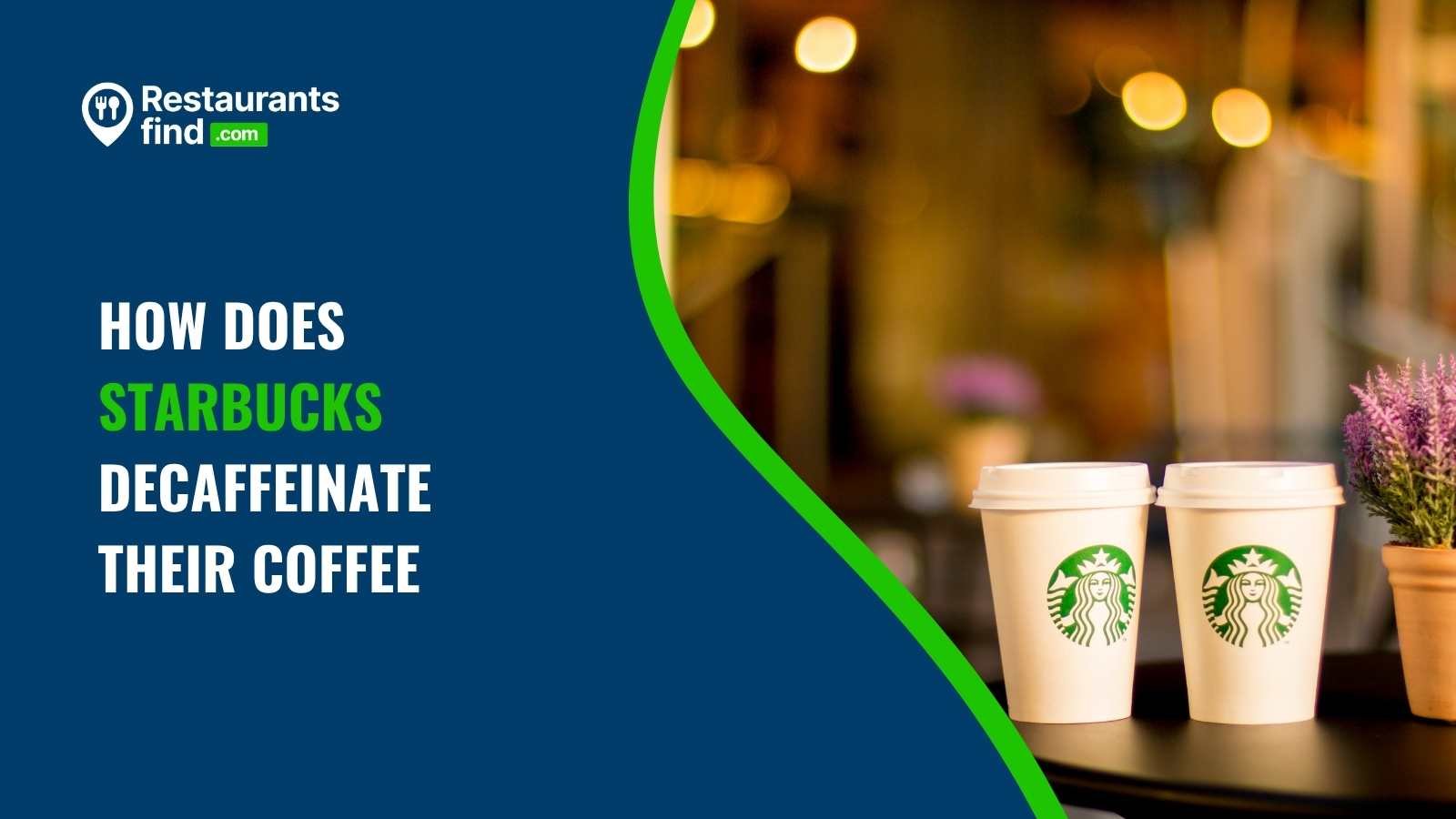How Does Starbucks Decaffeinate Their Coffee: If you love the taste of Starbucks coffee but want to cut back on caffeine, you might be wondering: How does Starbucks decaffeinate their coffee without losing the rich flavour? Decaffeinated coffee often gets a bad rap for being bland or lacking character, but Starbucks works hard to deliver a decaf brew that tastes just as satisfying. In this post, we’ll explore how Starbucks removes caffeine from their coffee beans, the methods they use, and why their decaf options remain a favourite for many.
What Does Decaffeination Mean?
Decaffeination is the process of removing caffeine from coffee beans while keeping as much of the original flavour intact as possible. Caffeine is a natural stimulant found in coffee, tea, and other plants, and some people prefer decaf to reduce jitters, improve sleep, or limit caffeine intake for health reasons.

The key challenge for any coffee roaster is to extract caffeine without stripping the beans of their complex aromas and tastes. Starbucks takes this seriously and uses careful processes to ensure their decaf coffee is rich, smooth, and enjoyable.
Also Read: What is the price of Starbucks Coffee in India
How Does Starbucks Decaffeinate Their Coffee?
Starbucks mainly uses two trusted decaffeination processes for their decaf coffee beans: the Swiss Water Process and the CO2 (carbon dioxide) Process. Both methods avoid harsh chemicals and focus on preserving the natural flavour of the coffee.
1. Swiss Water Process — Chemical-Free and Gentle
The Swiss Water Process is a chemical-free method that uses only water to remove caffeine. Here’s how it works:
- Coffee beans are soaked in hot water to dissolve caffeine along with other soluble compounds.
- This water, now containing coffee solids and caffeine, is passed through a carbon filter that traps caffeine molecules but lets other compounds flow through.
- The caffeine-free, flavour-rich water is then used to soak a fresh batch of beans, which lose their caffeine to the water but keep the flavour compounds since the water is already saturated with those.
- This cycle continues until the beans are 99.9% caffeine-free.
Why Starbucks Likes It:
The Swiss Water Process maintains the beans’ natural taste without using any chemical solvents. It’s a popular choice for organic and high-quality decaf coffee, making it a perfect fit for Starbucks’ premium standards.
2. CO2 Process — Precision and Flavour Preservation
The CO2 or Supercritical Carbon Dioxide Process uses carbon dioxide under high pressure to selectively extract caffeine from coffee beans.
- Green coffee beans are soaked in water to open their pores.
- The beans are then placed in a chamber where supercritical CO2 (a state between gas and liquid) is passed through.
- This CO2 binds specifically to caffeine molecules and draws them out, leaving other flavour compounds mostly untouched.
- The caffeine-rich CO2 is then transferred to another chamber where the caffeine is removed, and the CO2 is recycled.
Why Starbucks Uses This Method:
The CO2 process is precise and efficient, ensuring most of the bean’s flavour stays intact. It’s widely used in commercial decaffeination because it balances quality with scalability.
Also Read: Is Contemporary Disney Resort Food and Drinks Included?
Does Starbucks Use Chemical Solvents to Decaffeinate Coffee?
You might have heard of other decaffeination methods that use chemicals like methylene chloride or ethyl acetate. While these solvent-based processes are common in the industry, Starbucks avoids using them for their decaf coffees. The company prefers the Swiss Water and CO2 methods because they:
- Are safer and avoid chemical residues.
- Better preserve the natural coffee flavours.
- Align with Starbucks’ quality and sustainability goals.
How Does Starbucks Ensure Quality and Taste in Their Decaf Coffee?
Decaf coffee can sometimes taste flat or stale if not handled carefully. Starbucks applies rigorous quality controls to prevent this:
- They source premium coffee beans specifically selected for decaffeination.
- Their decaf beans undergo thorough flavour profiling to match the taste expectations of their blends.
- Caffeine levels are tested to confirm that decaf beans meet strict standards (usually 97-99% caffeine removal).
- Starbucks roasts decaf beans separately to bring out their unique flavour profile.
This attention to detail helps Starbucks deliver decaf coffee that offers rich aroma, balanced acidity, and a smooth finish — just like their regular coffee.
What About Sustainability and Ethical Sourcing?
Starbucks is known for its commitment to ethical sourcing and environmental responsibility. This applies to their decaf coffee too:
- The coffee beans chosen for decaf come from farms that meet Starbucks’ Coffee and Farmer Equity (C.A.F.E.) Practices.
- The Swiss Water Process uses no chemicals and reuses water, making it environmentally friendly.
- The CO2 process recycles carbon dioxide, limiting environmental impact.
- Starbucks invests in sustainable farming practices that support farmers and reduce carbon footprint.
By focusing on sustainable decaffeination methods, Starbucks ensures you can enjoy your decaf coffee with a clear conscience.
Why Choose Starbucks Decaf Coffee?
If you’re wondering whether Starbucks decaf is worth trying, here’s why many choose it:
- Low caffeine: Removes 97-99% of caffeine, great for sensitive individuals.
- Great taste: Carefully processed to keep the signature Starbucks flavour.
- Ethical sourcing: Beans come from farms that follow responsible practices.
- Variety: Starbucks offers multiple decaf blends, including espresso and brewed coffee options.
- Trust: Decades of experience in coffee roasting and decaffeination.
Final Thoughts
Starbucks decaffeinates their coffee using advanced, safe methods like the Swiss Water Process and CO2 Process. Both focus on removing caffeine while preserving the rich, complex flavours you expect. By avoiding chemical solvents and prioritising sustainability, Starbucks offers decaf coffee that’s both delicious and responsibly sourced.
Next time you want a comforting cup without the caffeine buzz, Starbucks decaf is a choice that delivers flavour, quality, and peace of mind.
Have you tried Starbucks decaf? What’s your favourite blend? Let us know in the comments!
Also Read: Do All-Inclusive Resorts Include Food? A Complete Guide to What You Can Expect
FAQs
What process of decaffeination does Starbucks use?
Starbucks primarily uses two gentle and flavour-preserving methods to decaffeinate their coffee beans: the Swiss Water Process and the CO2 (carbon dioxide) Process. The Swiss Water Process is chemical-free and relies solely on water and carbon filters to remove caffeine, preserving the beans’ natural flavours. The CO2 Process uses supercritical carbon dioxide to selectively extract caffeine under high pressure, ensuring the taste remains largely intact. Starbucks prefers these methods as they maintain the rich aroma and complex taste profiles expected from their coffee, while also aligning with their commitment to safety and sustainability.
Does Starbucks decaf coffee use methylene chloride?
No, Starbucks does not use methylene chloride to decaffeinate their coffee. Methylene chloride is a chemical solvent commonly employed in some decaffeination methods, but Starbucks avoids solvent-based processes to ensure the highest safety and flavour standards. Instead, Starbucks chooses the Swiss Water Process and CO2 Process, both of which eliminate caffeine without chemical residues. This choice reflects Starbucks’ dedication to delivering decaf coffee that is free from potentially harmful solvents and rich in natural flavour.
Is Starbucks coffee naturally decaffeinated? Is methylene chloride decaffeination safe?
Starbucks coffee is not naturally decaffeinated. All coffee beans naturally contain caffeine; decaffeination is a processing step that removes most of it. Starbucks uses carefully controlled decaffeination methods to reduce caffeine content by 97-99%.
Regarding safety, methylene chloride decaffeination is approved by food safety authorities, including the U.S. Food and Drug Administration (FDA), when residue levels are within strict limits. However, some consumers prefer to avoid any chemical solvents due to concerns about potential health effects and flavour impact. That’s why Starbucks opts for solvent-free methods like the Swiss Water Process or CO2 Process, which many consider safer and cleaner. This approach ensures their decaf coffee meets both safety standards and consumer expectations for quality and taste.
Does NESCAFÉ use methylene chloride?
NESCAFÉ, produced by Nestlé, offers various instant coffee products, some of which include decaffeinated options. NESCAFÉ does use a range of decaffeination methods depending on the product and region, including solvent-based methods like methylene chloride and ethyl acetate for some of their decaf coffees. However, they also use water-based and CO2 decaffeination processes for other products.
It’s important to note that solvent-based decaffeination, including methylene chloride, is regulated and deemed safe by health authorities when used properly. Still, NESCAFÉ and many other brands provide options for consumers seeking coffee decaffeinated without chemical solvents, often labelled as Swiss Water Process or naturally decaffeinated. If avoiding chemical solvents is a priority, checking the packaging or product details for the decaffeination method is recommended.
